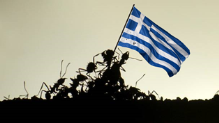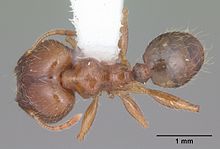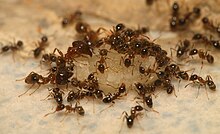You are here
Formicidae
Pheidole megacephala (Fabricius,1793)
EOL Text
urban areas, uncommon
| License | http://creativecommons.org/licenses/by-nc-sa/1.0/ |
| Rights holder/Author | AntWeb |
| Source | http://www.antweb.org/description.do?genus=pheidole&name=megacephala&rank=species |
Pheidole megacephala is a species of ant in the family Formicidae. It is commonly known as the bigheaded ant in the USA and the coastal brown ant in Australia. It is a very successful invasive species and is considered a danger to native ants in Australia [2] and other places. It has been nominated as one of the hundred "World's Worst" invaders.[1]
Distribution[edit]
Pheidole megacephala was described from a specimen from the island of Mauritius by the entomologist, Johan Christian Fabricius in 1793, although a previous record exists for Egypt 18 years earlier (see Synonyms). Regardless of its original distribution, bigheaded ants have since spread to many tropical and subtropical parts of the world.[3]
Description[edit]
There are two types of worker ant, the major or soldier ant and the minor worker. The common name of bigheaded ant derives from the soldier's disproportionately large head. This has large mandibles which may be used to crush seeds. The soldiers are about four millimetres in length, twice as long as the minor workers. The colour of both types varies from yellowish-brown or reddish-brown to nearly black. The rear half of the head is smooth and glossy and the front half sculptured. The twelve-segmented antennae are curved and have club-like tips. The waist or petiole is two-segmented with the node immediately behind conspicuously swollen. There are a pair of short, upward-facing spines on the waist. The body has sparse, long hairs.[3]
Biology[edit]
Bigheaded ants nest in colonies underground. Colonies can have several queens [4] and super-colonies can be formed by budding, when a queen and workers leave the original nest and set up a new colony nearby without swarming.[5] In Florida, nuptial flights of winged ants take place during the winter and spring and afterwards, fertilized queens shed their wings and find a suitable site to found a new colony where they start laying eggs.[3] Each queen lays up to 290 eggs per month. The eggs hatch after two to four weeks and the legless white larvae, which are fed by the workers, pupate about a month later. The adult workers emerge ten to twenty days after that.[6]
The bigheaded ants feed on dead insects, small invertebrates and honeydew excreted by insects such as aphids, soft scale insects, mealybugs, whiteflies and planthoppers. These sap-sucking bugs thrive in the presence of bigheaded ants, being more abundant on plants patrolled by ants than on those not so patrolled.[7]Green scale, Coccus viridis, flourished when bigheaded ants protected their food source by removing predators such as lady beetle larvae and lepidopteran larvae.[8] The minor workers are much more numerous than the soldiers. Trails of ants lead up trunks, along branches and into the canopies of trees and debris-covered foraging tunnels with numerous entrances are created on the surface of the ground. These may be confused with similar tubes built by subterranean termites. Foraging ants will alert others to new food sources. Honeydew is ingested but other foodstuffs are carried back to the nest by both major and minor workers who may transfer items of food between themselves. Anything too big to be moved may be dissected before being brought back to the nest.[3]
P. megacephala can also live indoors.[9]
References[edit]
- ^ a b Global Invasive Species Database
- ^ An invasion revisited: the African big-headed ant (Pheidole megacephala) in northern Australia
- ^ a b c d Featured Creatures
- ^ Wilson EO. 2003. Pheidole in the New World, a Dominant, Hyperdiverse Ant Genus. Harvard University Press. Cambridge, MA. 794 pp.
- ^ The Pest Ants of Florida
- ^ Hoffman B. 2006. Pheidole megacephala (insect). CSIRO Sustainable Ecosystems
- ^ Impact of Pheidole megacephala (F.) (Hymenoptera: Formicidae) on the Biological Control of Dysmicoccus brevipes (Cockerell) (Homoptera: Pseudococcidae)
- ^ Direct and indirect interactions between ants (Pheidole megacephala), scales (Coccus viridis) and plants (Pluchea indica)
- ^ http://flrec.ifas.ufl.edu/entomo/ants/pest%20ants%20of%20fl/big_headed_ant.htm
| License | http://creativecommons.org/licenses/by-sa/3.0/ |
| Rights holder/Author | Wikipedia |
| Source | http://en.wikipedia.org/w/index.php?title=Pheidole_megacephala&oldid=621541587 |
Figs. 15a-g
Formica megacephala Fabricius , 1793: 36. Roger 1863b: 30 (combination in Pheidole ). Syntype(s): major, no locality given, not examined.
Myrmica trinodis Losana , 1834: 327. Roger 1863b: 30 (junior synonym of megacephala ). Syntype(s): "worker", Italy, not examined.
Formica edax Forskal , 1775: 84. Emery 1892: 160 (junior synonym of megacephala ), Dalla Torre 1892: 90 (same). Syntype(s): "worker", Egypt, not examined.
Oecophthora perniciosa Gerstacker , 1859: 263. Roger 1863b: 31 (combination in Pheidole ), Emery, 1915c: 235 (junior synonym of megacephala ). Syntype(s): "worker", Mozambique, not examined.
Oecophthora pusilla Heer , 1852: 15. F. Smith 1858: 173 (combination in Pheidole ), Roger 1859: 259 (senior synonym of laevigata Fr. Smith , 1855: 130), Mayr 1870: 981 (senior synonym of laevigata Mayr , 1862: 747), Mayr 1886: 360 (senior synonym of janus ), Emery 1915: 235 (subspecies of megacephala ), Wheeler 1922: 812 (junior synonym of megacephala ). Syntypes: major, minor, queen & male, Madeira, not examined.
Myrmica agilis F. Smith , 1857: 71. Donisthorpe 1932: 449 (combination in Pheidole ). Syn.n. Syntypes: 3 minors, "MALAC" [= Malacca, S. Malay Peninsula], OXUM TYPE HYM: 988 1-3/3, examined.
Myrmica suspiciosa F. Smith , 1859: 148. Donisthorpe 1932: 455 (junior synonym of megacephala ). Syntype (s): "worker", Aru I. (Indonesia), not examined.
Atta testacea F. Smith , 1858: 168. Mayr 1886: 360 (combination in Pheidole ), Brown, 1981: 530 (junior synonym of megacephala ). Syntypes: major & minor, Brazil, not examined.
Subspecies enumerated in Bolton, 1995: nominal plus costauriensis Santschi , 1914: 443, syntype(s): major, Ghana, not examined; duplex Santschi , 1937a: 220, syntypes: major, minor & queen, Angola, not examined; ilgi Forel , 1907: 82, syntypes: major & minor, Ethiopia, not examined.; impressifrons Wasmann , 1905: 110 (replacement name for impressiceps Wasmann , 1904: 72), syntypes: major, minor & queen, South Africa, not examined; melancholica Santschi , 1912: 164, syntypes: major & minor, Ivory Coast, not examined; nkomoana Forel , 1916: 415, syntypes: major, minor, queen & male, Zaire, not examined; rotundata Forel , 1894: 92, syntypes: major & minor, Mozambique, not examined; scabrior Forel , 1891: 178, syntypes: major & minor, Madagascar, not examined; speculifrons Stitz , 1911: 386, syntypes: major & minor, Tanzania, not examined; talpa Gerstacker , 1871: 356, syntypes: "worker" & queen, Kenya, not examined. For these forms type material not examined.
Other material examined: S. China: Hong Kong: Victoria Park, Hong Kong I. [K. Eguchi]; Macau: Mong Ha [K. Eguchi]. N. Vietnam: Ha Noi: Hanoi Agric. Univ. (Gia Lam) [K. Ogata: 15-min TUS #2]; Quang Ninh: Hoanh Bo [K. Eguchi]. S. Vietnam: Vinh Long (misspelled as "Vinlong"): Vinh Long (10°15'N, 105°58'N) [S. Kawaguchi]. Thailand: Trang: Khao Chong Waterfall [Eg01-VN-761]. W. Malaysia: Penang: beside a building of Univ. Sains Malaysia [C.Y. Lee]. E. Malaysia: Sabah: Kota Kinabalu [Eg97-BOR-376], Tambunan Village [H. Okido], Danam Valley [Eg96-BOR-108]. Indonesia: Kalimantan Timur: Tandjung Isuy [Seyfert & Graindl]; Irian Jaya: Wamena, 1600 m alt. [Eg98-IRI-674, -675, -676, -703]. Australia: Queensland: S. Mission Beach near Tully [AU01-SKY-12]. Tonga: Tongatapu: Vaini [J.K. Wetterer].
Worker measurements & indices: Major (n=5). - HL 1.28-1.45 mm; HW 1.25-1.45 mm; CI 98-100; SL 0.71-0.76 mm; SI 52-57; FL 0.94-0.98 mm; FI 68-77.
Minor (n=5). - HL 0.62-0.72 mm; HW 0.55-0.65 mm; CI 88-91; SL 0.67-0.73 mm; SI 111-121; FL 0.68-0.77 mm; FI 118-123. Worker description
Major. - Head in lateral view roundly convex dorsally, not impressed on vertex, in full-face view shallowly concave posteriorly; frons longitudinally rugose (or rarely almost smooth, only sparsely with short interrupted longitudinal rugulae); vertex and dorsum of vertexal lobe smooth and shining or shagreened; frontal carina absent or present just as weak rugula(e); antennal scrobe absent; median longitudinal carina of clypeus weak or absent; hypostoma at most with a pair of very small or inconspicuous submedian processes in addition to a pair of conspicuous lateral processes; antenna with a 3-segmented club; maximal diameter of eye almost as long as or longer than antennal segment X. Promesonotal dome in dorsal view smooth and shining or shagreened, sometimes with several weak transverse rugulae, in lateral view at most with an inconspicuous mound on its posterior slope; humerus not or weakly produced laterad; the dome at the humeri narrower than at the bottom; mesopleuron, metapleuron and lateral face of propodeum weakly or very weakly punctured. Petiole a little longer than postpetiole (excluding helcium); postpetiole not massive; its anteroventral part weakly swollen. First gastral tergite smooth and shining entirely, or very weakly punctured around its articulation with postpetiole and smooth or shagreened in the remainder.
Minor. - Head smooth and shining; preoccipital carina weak but present dorsally and laterally; median part of clypeus smooth and shining, without a median longitudinal carina; antenna with a 3-segmented club; scape extending beyond posterolateral margin of head by the double length of antennal segment II or more; maximal diameter of eye almost as long as, or sometimes a little shorter than antennal segment X. Promesonotal dome smooth and shining, in lateral view lacking a mound on its posterior slope; humerus in dorso-oblique view not or hardly produced; mesopleuron, metapleuron and lateral face of propodeum punctured weakly; metanotal groove inconspicuous. Petiole almost as long as or a little longer than postpetiole (excluding helcium); postpetiole relatively long but not massive; its anteroventral part weakly swollen.
Recognition: The syntype minors of " Myrmica agilis " agree well with minors of Bornean populations (e.g., Eg96-BOR-108) of P megacephala . I conclude that P agilis is a juninor synonym of P megacephala .
P. megacephala is well distinguished from Indo-Chinese species by the combination of the following characteristics: in the major head in full-face view only shallowly concave posteriorly; in the major dorsum of vertexal lobe smooth and shining or shagreened; in the major hypostoma in the middle at most with a pair of very small or inconspicuous submedian processes; in the minor preoccipital carina weak but present dorsally and laterally; posterior slope of promesonotal dome at most with an inconspicuous mound in the major, and without any mound in the minor; in the major and minor anteroventral part of postpetiole weakly swollen.
Distribution & bionomics: Widely distributed in the world tropics and subtropics. For detailed information on biology and ecological and economic impacts of this species see Reimer et al. (1993), Campbell (1994), Hoffmann (1998), Wetterer (1998), Hoffmann et al. (1999), Vanderwoude et al. (2000), etc.
| License | |
| Rights holder/Author | No known copyright restrictions |
| Source | http://hdl.handle.net/10199/19085 |
Race megacephala HNS (sensu stricto)
. T91, Gouela. Prairie a 1.600 m. (LaMOTTE). Peu commune.
| License | Public Domain |
| Rights holder/Author | No known copyright restrictions apply. See Agosti, D., Egloff, W., 2009. Taxonomic information exchange and copyright: the Plazi approach. BMC Research Notes 2009, 2:53 for further explanation. |
| Source | http://treatment.plazi.org/id/A4A8C4DC99F3E890BDBFA65863EE7632 |
Pheidole megacephala (Fabricius) HNS
Formica megacephala Fabricius HNS 1793: 161. Combination in Pheidole HNS by Roger 1863b: 30. Extensive synonymy and citation of infraspecific forms cited by Bolton 1995b.
Types Unknown.
Etymology Gr L megacephala HNS , large-headed, referring to the major.
Diagnosis Major and minor: in side view, entire postpetiole oval in shape, with all of the ventral margin bulging in a conspicuous convexity, and the node oval, low, and weakly developed; mesonotal convexity absent, the promesonotal profile forming a nearly smooth semicircle; color brownish yellow.
Major: outline of head plus mandibles in full-face view forms a near-perfect heart shape; rugoreticulum present between eye and antennal fossa.
Minor: occiput broad, lacking an occipital collar.
Measurements (mm) Major (Grand Bahama Island): HW 1.32, HL 1.32, SL 0.64, EL 0.18, PW 0.60. Minor (Grand Bahama Island): HW 0.54, HL 0.62, SL 0.66, EL 0.12, PW 0.34. color Major and minor: brownish yellow.
Range Widespread although spottily distributed, and sometimes locally very abundant, from southern Florida, Bermuda, and the Bahamas south through the West Indies, southern Mexico, and Central America, to as far south in South America as Santa Catarina, Brazil.
Biology The colonies, which are continuous, with no evident pheromone-based boundaries, and large numbers of fertile queens, are able to reach enormous size. In some areas, especially islands such as Madeira, Culebrita, and the Dry Tortugas, they form a virtually continuous supercolony that excludes most other ant species. They do best in relatively moist, disturbed habitats, thus thrive around human habitations and in cultivated land. Nest sites are highly variable, from within and beneath rotting logs and underneath rocks and sidewalk flagstones to the bark and trunk-based detritus of standing trees. Columns of foragers travel substantial distances from one nest site to another and to food sources. P. megacephala HNS are aggressive toward other species, and war with populations of such locally dominant species as the Indo-Australian weaver ant Oecophylla smaragdina HNS and the cosmopolitan Argentine ant Linepithema humile HNS (= Iridomyrmex humilis HNS ). General accounts of this important species are given by Wilson (1971), Holldobler and Wilson (1990), and D. F. Williams et al. (1994). A bibliography of the ant for North America is provided by D. R. Smith (1979). The devastating effect on the native Hawaiian insect fauna was described by the pioneering entomologist R. C. L. Perkins (1913).
Figure Upper: major. Lower: minor. BAHAMAS: Grand Bahama Island. (Type locality not cited.) Types not seen. Scale bars = 1 mm.
| License | Public Domain |
| Rights holder/Author | No known copyright restrictions apply. See Agosti, D., Egloff, W., 2009. Taxonomic information exchange and copyright: the Plazi approach. BMC Research Notes 2009, 2:53 for further explanation. |
| Source | http://treatment.plazi.org/id/A3AB6A5A7F5617C4AF434D8356DB9EF8 |
Diagnosis of worker among Antkey species. Worker castes bimorphic. Head shape ovoid (minor workers) or weakly heart-shaped with posterolateral lobes (majors), but never triangular. Antenna 12-segmented. Antennal club 3-segmented. Antennal insertions at least partly covered by frontal lobes; not surrounded by a raised sharp-edged ridge. Frontal lobes do not obscure face outline between mandible and eye; relatively close together so that the posteromedian portion of the clypeus, where it projects between the frontal lobes, is at most only slightly broader than one of the lobes. Posterolateral corners of head unarmed, without spines. Mandibles triangular. Mesosoma with erect hairs. Pronotal spines absent. Propodeum armed with spines or teeth. Slope of mesosoma steep. Waist 2-segmented. Petiole pedunculate with a distinct and upright node; lacking large subpetiolar process. Postpetiole attached to lower surface of gaster. Color yellowish brown to brown. Minor worker characters. Head smooth and shining, lacking punctation. Antennal scrobe lacking. Postpetiole swollen relative to petiole. Major worker characters. Antennal scrobe weak to absent; no depression capable of receiving antennal scapes clearly visible. Posterolateral lobes smooth and shining, lacking rugae and punctation.
Minor workers of P. megacephala are most easily distinguished from P. anastasii, P. bilimeki, P. flavens, P. moerens and P. punctatissima by the smooth and shining head. They are most easily separated from the remaining Antkey Pheidole minors by the postpetiole, which is distinctly swollen in comparison to the petiole. The major workers are separated from all other Antkey Pheidole majors in the United States by the heart-shaped head and by the smooth and shining posterolateral lobes that lack both rugae and punctation.
| License | http://creativecommons.org/licenses/by-sa/3.0/ |
| Rights holder/Author | Eli Sarnat, Antkey |
| Source | http://antkey.org/node/32655 |
26. Pheidole megacephala Fabr HNS .
- Colombo, Kandy.
| License | Public Domain |
| Rights holder/Author | No known copyright restrictions apply. See Agosti, D., Egloff, W., 2009. Taxonomic information exchange and copyright: the Plazi approach. BMC Research Notes 2009, 2:53 for further explanation. |
| Source | http://treatment.plazi.org/id/9E1C97A5F6AEAEE9E171A437CEBB2B91 |
The following is a representative barcode sequence, the centroid of all available sequences for this species.
There are 48 barcode sequences available from BOLD and GenBank.
Below is a sequence of the barcode region Cytochrome oxidase subunit 1 (COI or COX1) from a member of the species.
See the BOLD taxonomy browser for more complete information about this specimen and other sequences.
-- end --
1. Pheidole megacephala HNS
, Smith, Proc. Linn. Soc. Supp. v. 112. 5.
Mr. Wallace has sent a series of workers of this species collected from the nest. These contain, as it were, three modifications of the enormously large-headed individuals; all of these have heads similar in form, subquadrate, longitudinally striated anteriorly, and transversely so behind; these I should call varieties of the worker major; the worker minor has the head subovate in form, smooth, polished and shining; not striated behind, and very faintly so anteriorly. The links which would unite these two distinct forms of the working ants are wanting. I am therefore still of opinion that societies of ants generally possess two distinct sets of workers whose functions are totally different; this is known to be the case in slave-making communities, and also in the remarkable genus Eciton HNS , of which only the workers are known.
| License | Public Domain |
| Rights holder/Author | No known copyright restrictions apply. See Agosti, D., Egloff, W., 2009. Taxonomic information exchange and copyright: the Plazi approach. BMC Research Notes 2009, 2:53 for further explanation. |
| Source | http://treatment.plazi.org/id/863819B99013E6D3F3456F028EE80BB3 |
24. P. megacephala Fabr HNS .
Bagamoyo und Kihengo.
| License | Public Domain |
| Rights holder/Author | No known copyright restrictions apply. See Agosti, D., Egloff, W., 2009. Taxonomic information exchange and copyright: the Plazi approach. BMC Research Notes 2009, 2:53 for further explanation. |
| Source | http://treatment.plazi.org/id/7D89E9B79FCF604B154A0633ADB22DB2 |


